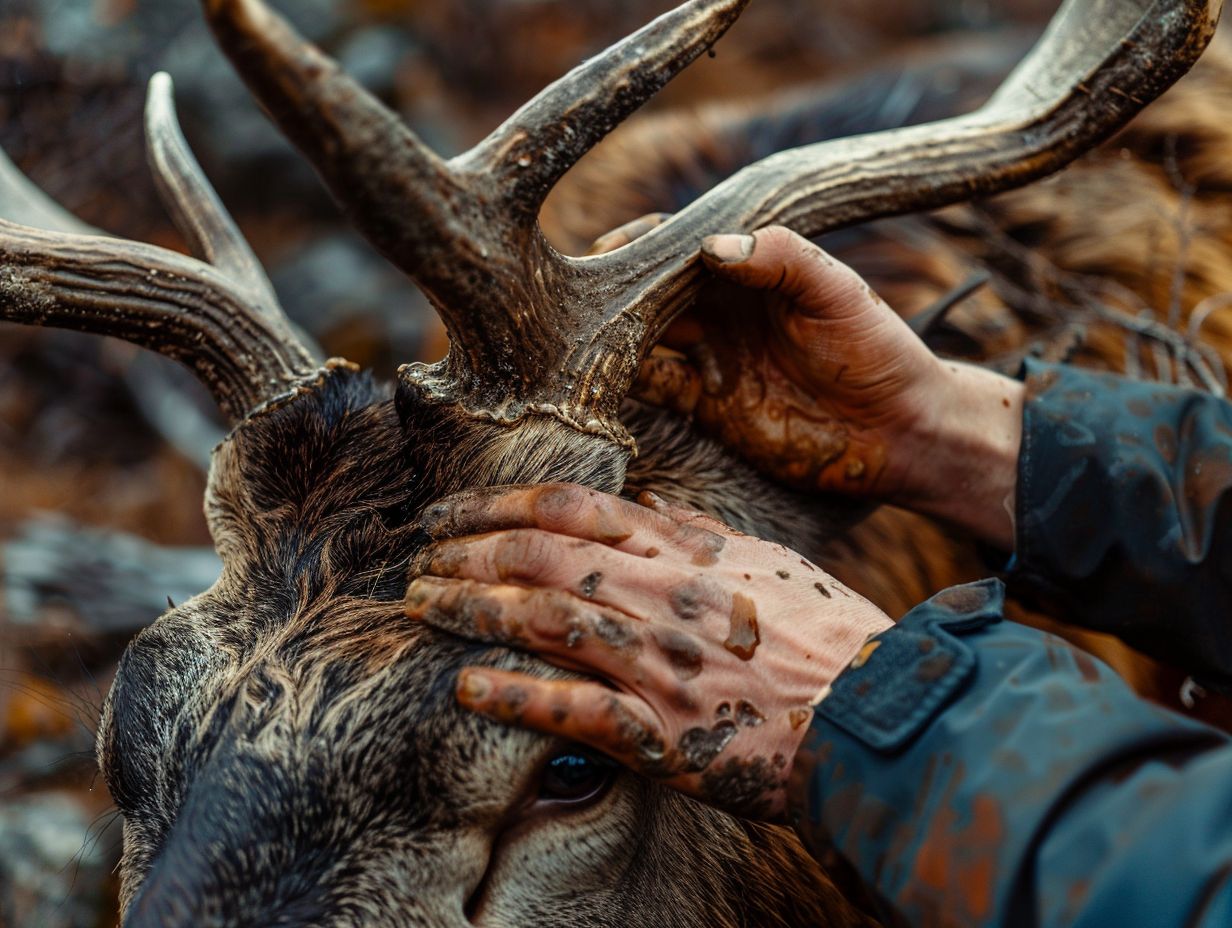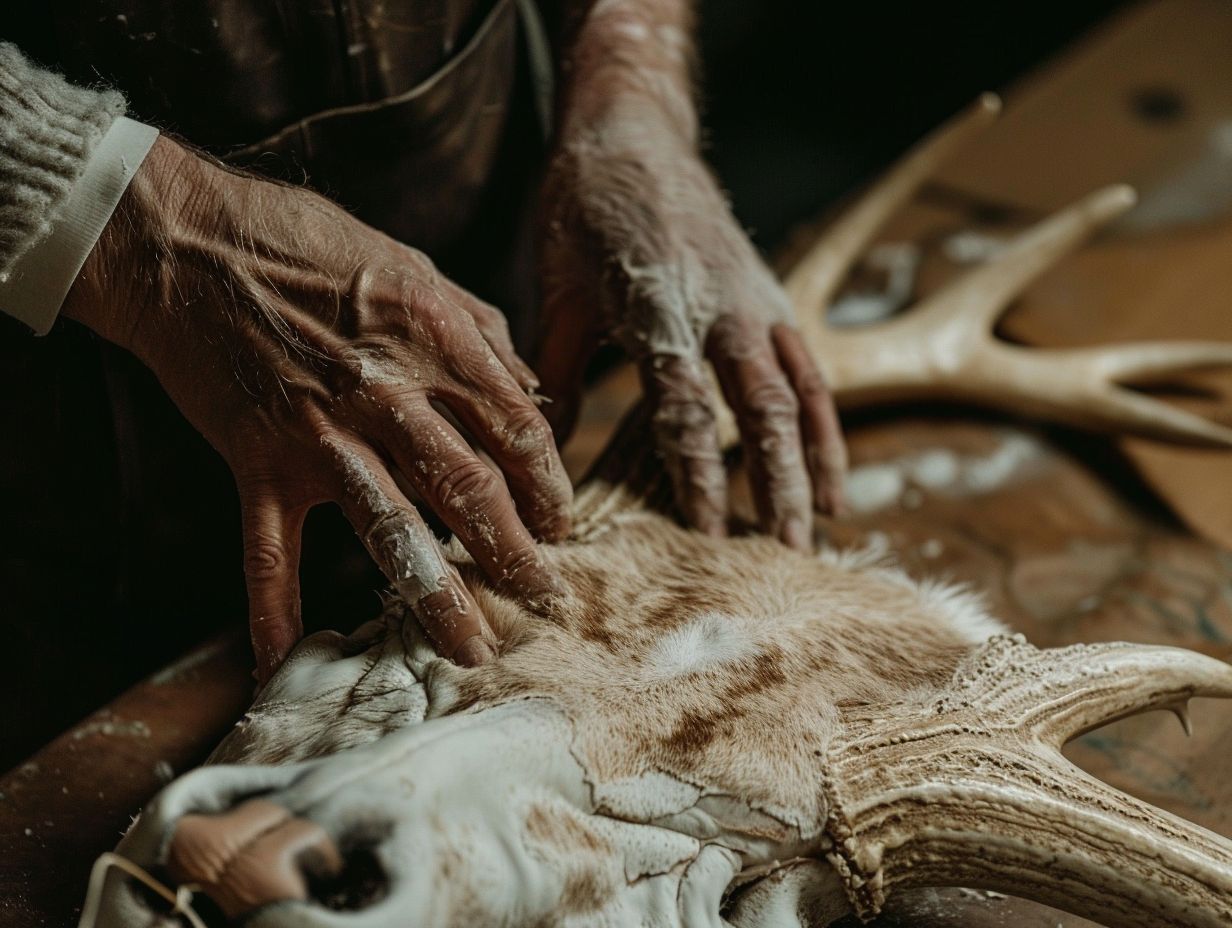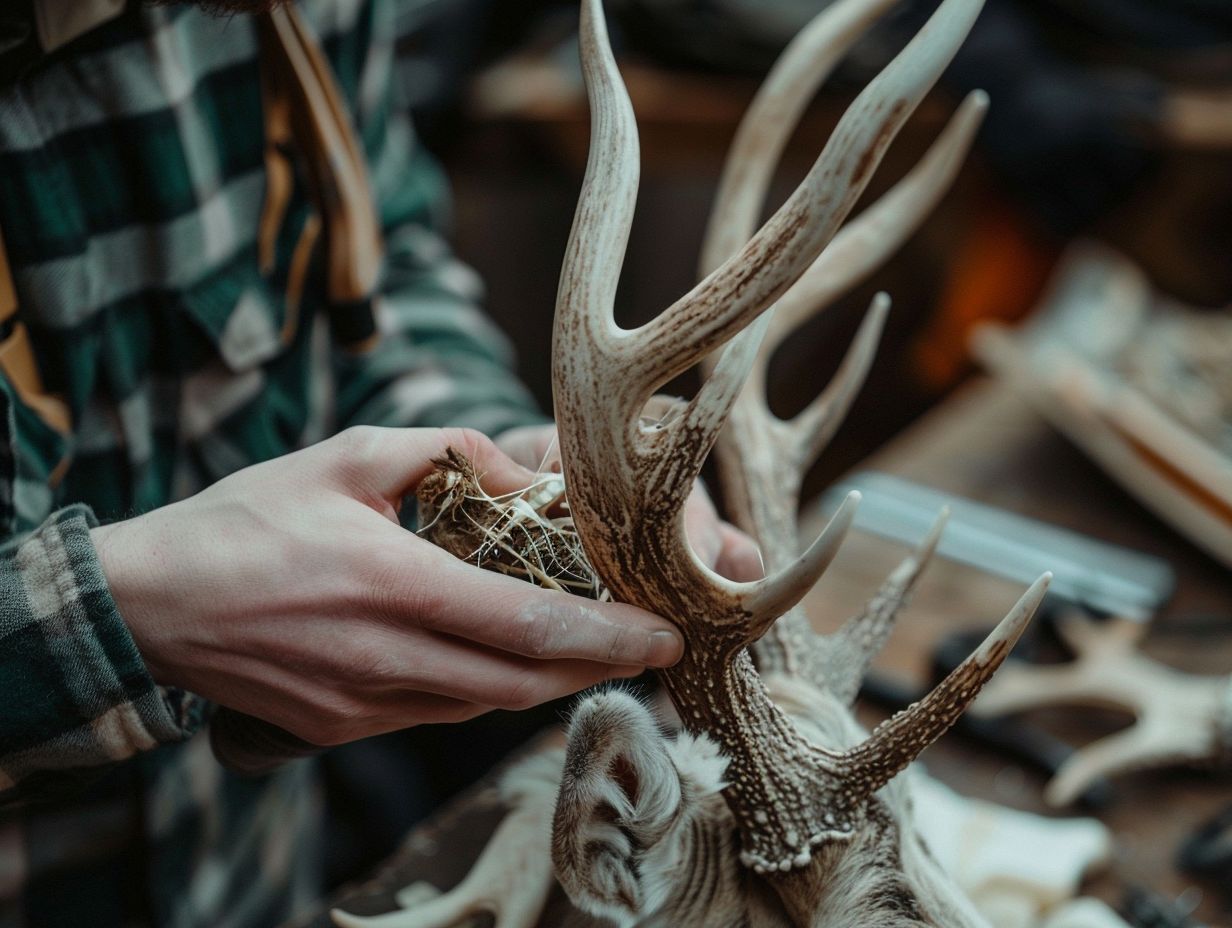Deer Antler Velvet Removal

Deer antler velvet is a popular natural substance with a range of potential health benefits. In this article, we will explore the different methods of deer antler velvet removal, including its use in traditional and modern medicine. We will also discuss the potential side effects of this process and look at alternatives to deer antler velvet removal. Furthermore, we will address the legality and regulations surrounding the removal of deer antler velvet. Whether you are curious about the ethical considerations or simply want to learn more about this fascinating substance, this article has all the information you need.
Key Takeaways:

- Deer antler velvet removal is the process of removing the soft, velvety tissue from the antlers of deer.
- There are various methods of deer antler velvet removal, including cutting, scraping, and sawing.
- Deer antler velvet has both traditional and modern medicinal uses and is believed to have anti-inflammatory and performance-enhancing properties.
- Potential side effects of deer antler velvet removal include infection, nerve damage, and excessive bleeding.
- There are ethical and synthetic alternatives to deer antler velvet removal, such as obtaining it from naturally shed antlers or using synthetic versions.
- The legality of deer antler velvet removal varies by country and is subject to regulations to ensure humane treatment of deer.
How Is Deer Antler Velvet Removed?
The process of Deer Antler Velvet removal involves a precise procedure that ensures both the welfare of the deer and the quality of the harvested velvet. It is a meticulous collection process that adheres to industry standards and guidelines.
During the removal process, the **antlers** are carefully harvested under controlled conditions to minimize stress and discomfort for the deer. Specialized tools are used by trained professionals to ensure a gentle and efficient extraction of the velvet.
Quality control measures are implemented to verify the purity and potency of the harvested velvet. This includes rigorous testing for contaminants and adherence to strict processing protocols to maintain the integrity of the product.
What Are The Different Methods Of Deer Antler Velvet Removal?
The different methods of Deer Antler Velvet removal vary from traditional manual techniques to modern technological solutions. These methods ensure efficient and humane collection of the velvet while maintaining the integrity of the product.
In traditional manual techniques, skilled workers delicately hand-harvest the velvet from the deer using careful methods that prioritize the animal’s well-being. This approach has been practiced for centuries and relies on experienced individuals who understand the anatomy of the deer.
On the other hand, modern technological solutions incorporate innovative tools and machinery designed for precise and quick extraction without causing harm to the deer. These methods often involve gentle processing techniques that minimize stress on the animals, resulting in a high-quality velvet product.
What Are The Uses Of Deer Antler Velvet?
Deer Antler Velvet finds applications in various industries, including the production of deer velvet supplements and processing into different forms such as capsules, liquid extracts, and tablets. Its versatile nature makes it a valuable raw material.
One of the key aspects of utilizing Deer Antler Velvet in supplements lies in its rich source of essential nutrients such as amino acids, growth factors, and minerals, which are beneficial for overall health and well-being.
Through specialized processing methods, the velvet undergoes meticulous extraction processes to ensure the preservation of its bioactive compounds and efficacy. This involves techniques like freeze-drying, ethanol extraction, or powder encapsulation to retain the potency of the velvet’s beneficial components.
The transformation of Deer Antler Velvet into different consumable forms opens up a wide range of possibilities for consumers. Whether in the form of powder for smoothies, capsules for easy consumption, or liquid extracts for rapid absorption, the versatility of velvet allows for tailored applications based on individual preferences and needs.
Is Deer Antler Velvet Used In Traditional Medicine?

Deer Antler Velvet has a long history in traditional medicine, where it is believed to possess healing properties and therapeutic benefits. Its use in ancient remedies and tonics showcases its significance in traditional healing practices.
The utilization of Deer Antler Velvet dates back centuries, with ancient Chinese physicians considering it a potent remedy for various ailments. In traditional Chinese medicine, it is highly valued for its ability to strengthen the body, improve vitality, and promote overall wellness.
In Korean, Japanese, and Russian traditional medicine systems, Deer Antler Velvet is also revered for its rejuvenating qualities and believed to support joint health and immune function.
Is Deer Antler Velvet Used In Modern Medicine?
In modern medicine, Deer Antler Velvet is being studied for its potential health benefits and medicinal properties. Research is ongoing to explore its efficacy in various medical treatments and its potential contribution to modern healthcare practices.
Recent studies have shown promising results in the use of Deer Antler Velvet extracts to support joint health and reduce inflammation. The velvet-derived compounds are rich in growth factors and amino acids that have been linked to tissue repair and regeneration.
Ongoing research is investigating the potential benefits of Deer Antler Velvet in enhancing athletic performance and promoting muscle recovery. Some studies suggest that the velvet extract may have adaptogenic properties, helping the body adapt to stress and improve overall endurance.
What Are The Potential Side Effects Of Deer Antler Velvet Removal?
While Deer Antler Velvet removal is a carefully managed process, there are potential risks associated with the procedure. These risks include the possibility of infection, nerve damage, and excessive bleeding if not performed with precision and care.
Proper training and expertise are crucial when undertaking this procedure to minimize the chances of complications. Infection can occur if sterile techniques are not followed diligently throughout the removal process.
Additionally, nerve damage is a significant risk that highlights the importance of skilled hands and precise movements. To prevent excessive bleeding , it is vital to control the removal pace and avoid causing trauma to the surrounding tissues. Adherence to safety protocols is paramount to ensure a successful and risk-free procedure.
Can Deer Antler Velvet Removal Cause Infection?
Infection is a potential risk associated with Deer Antler Velvet removal if proper hygiene and sterilization protocols are not followed. The risk of infection can be minimized through stringent cleanliness and adherence to procedural standards.
During the harvesting process, it is crucial to ensure that the tools used are sanitized and that the extraction area is kept clean to prevent contamination.
- Properly cleaning the deer antler velvet before extraction can significantly reduce the presence of harmful bacteria.
- Employing sterilization methods such as autoclaving or chemical disinfection can also help in minimizing infection risks.
Maintaining a sterile environment and using protective gear like gloves and masks are essential precautions that should not be overlooked to safeguard against potential infections during the removal process.
Can Deer Antler Velvet Removal Cause Nerve Damage?
Nerve damage is a potential consequence of Deer Antler Velvet removal if the procedure is not performed with precision and expertise. Careful execution and understanding of the anatomy can help minimize the risk of nerve damage during the harvesting process.
When harvesting Deer Antler Velvet, it is crucial to avoid damaging the surrounding nerves, which can lead to significant complications. Skilled practitioners must be well-versed in the intricate network of nerves in the antler area to ensure a safe extraction process.
By employing proper techniques and having a detailed knowledge of nerve pathways, those conducting the procedure can reduce the chances of unintended nerve trauma. The delicacy required in this operation underscores the need for thorough training and experience in deer anatomy and surgical precision.
Can Deer Antler Velvet Removal Cause Excessive Bleeding?

Excessive bleeding can occur during Deer Antler Velvet removal if the process is not conducted carefully and with proper control. Hemostatic measures and skilled handling are essential to prevent excessive bleeding and ensure the welfare of the deer during the harvesting process.
To minimize the risk of bleeding complications, it is crucial for individuals involved in Deer Antler Velvet removal to be proficient in hemostatic techniques. Utilizing effective methods such as pressure application, cautery, and advanced wound care can help manage bleeding and promote quick healing.
Employing controlled procedures, including proper sterilization and precision in antler handling, can significantly reduce the likelihood of excessive bleeding. This attention to detail not only safeguards the deer’s well-being but also contributes to the overall success of the harvesting process.
What Are The Alternatives To Deer Antler Velvet Removal?
Exploring alternatives to Deer Antler Velvet removal involves ethical considerations and the development of synthetic substitutes that mimic the properties of natural velvet. These alternatives aim to provide sustainable options without compromising animal welfare.
One of the key aspects of developing these synthetic substitutes lies in replicating the bioactive components present in natural velvet, which contribute to its reported health benefits. Utilizing advanced biotechnological methods, researchers strive to create innovative solutions that can be ethically sourced and produced without the need for harvesting antlers from live deer.
Can Deer Antler Velvet Be Obtained Ethically Without Removal?
Ethical sourcing of Deer Antler Velvet without removal involves innovative approaches that prioritize the well-being of deer and eliminate the need for physical harvesting. These ethical practices aim to offer velvet products without causing harm or distress to the animals.
One of the most notable methods used in the ethical sourcing of Deer Antler Velvet is the development of ethical farms where deer are allowed to naturally shed their antlers, which are then collected without any harm to the animals.
Advancements in technology have enabled non-invasive techniques such as antler casting, where molds are made of the antlers, allowing for the production of velvet products without any interference in the natural growth process of the deer.
What Are The Synthetic Alternatives To Deer Antler Velvet?
Synthetic alternatives to Deer Antler Velvet offer a cruelty-free and sustainable option for consumers seeking velvet-derived products without the need for harvesting from live animals. These substitutes replicate the beneficial properties of natural velvet while promoting ethical practices.
One of the key benefits of synthetic substitutes for Deer Antler Velvet is their ability to be tailored to specific applications. Manufacturers can tweak the composition to optimize durability, texture, and other characteristics to suit different uses. This flexibility opens up a range of possibilities across industries like cosmetics, sports supplements, and traditional medicine, where the properties of velvet are highly valued.
Is Deer Antler Velvet Removal Legal?
The legality of Deer Antler Velvet removal is governed by specific regulations and guidelines that dictate the permissible practices and standards for harvesting velvet. Compliance with legal requirements is essential to ensure the ethical sourcing and processing of Deer Antler Velvet.
These regulations help protect the wildlife population and ensure sustainable practices in the industry. Adherence to these guidelines also safeguards against exploitation and supports conservation efforts.
It’s crucial for individuals and companies involved in the harvesting and processing of Deer Antler Velvet to stay informed about any updates or changes in the legal framework to avoid any potential legal repercussions. Consistent compliance not only secures the integrity of the industry but also promotes responsible and sustainable practices that benefit both the environment and the consumers.
What Are The Regulations Surrounding Deer Antler Velvet Removal?

The regulations governing Deer Antler Velvet removal encompass stringent procedures, industry standards, and welfare considerations for deer farms. These regulations aim to ensure the humane treatment of animals and the quality of harvested velvet products.
Within the regulatory framework, deer farmers are required to adhere to specific procedural guidelines when harvesting the velvet from farmed deer. This involves ensuring that the process is carried out in a manner that minimizes stress and discomfort to the animals.
Industry standards dictate the proper handling and storage of the velvet to maintain its purity and potency. Welfare guidelines outline the importance of providing proper care and nutrition to the deer to promote healthy antler growth and overall well-being.
Frequently Asked Questions
What is deer antler velvet removal?
Deer antler velvet removal is the process of removing the soft, velvety tissue that covers deer antlers. This tissue is rich in nutrients and is often used in traditional medicine for its potential health benefits.
How is deer antler velvet removed?
The most common method of deer antler velvet removal is by using a specialized saw or blade to carefully cut off the velvet from the antlers. This process is done while the antlers are still in their soft, growing stage.
Is deer antler velvet removal harmful to deer?
No, deer antler velvet removal is not harmful to deer when done correctly. In fact, the velvet is removed during a time when the antlers are still sensitive and the process does not cause any harm or pain to the deer.
What is deer antler velvet used for?
Deer antler velvet has been used in traditional medicine for centuries and is believed to have various health benefits such as improving joint health, boosting immune function, and increasing strength and endurance.
Is deer antler velvet removal legal?
Yes, deer antler velvet removal is legal in most countries. However, some regulations may vary so it is important to check with your local wildlife agency before attempting to remove deer antler velvet.
Can deer antler velvet be harvested without removing the antlers?
Yes, there are methods of harvesting deer antler velvet without removing the antlers. One method is to use a coring tool to extract the velvet without damaging the antlers. Another method is to inject a solution that stimulates the shedding of the velvet.